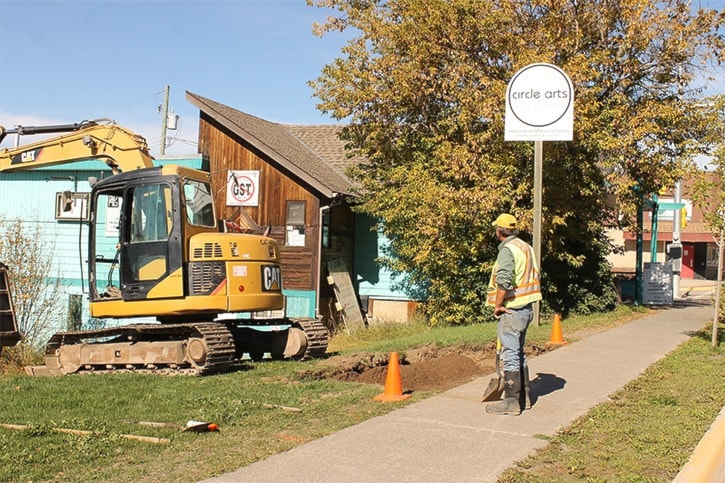A new bus shelter being built on Hwy. 16 right next to Process 4 circle arts Gallery in Burns Lake is raising questions over how this decision was made.
Wayne Brown, owner of Process 4 circle arts Gallery, said he is upset about the lack of consultation with local businesses owners, adding that the new shelter will make it harder for drivers to see his business sign. “Drivers won’t be able to see the sign as clearly as they see now, and I can’t keep raising the sign up,” he said.
The new bus shelter is part of the Hwy. 16 action plan, a $5 million plan that will have free buses connecting communities across the Hwy. 16 corridor - between Prince Rupert and Prince George.
During last week’s council meeting, councillors raised questions over why that specific location was chosen for a bus shelter, considering that the bus won’t actually be able to stop there. The bus will be required to stop in the RV parking lot close to the shelter.
During the meeting, Sheryl Worthing, Chief Administrative Officer for the Village of Burns Lake, said the decision on the location was made by the B.C. Ministry of Transportation and Infrastructure.
However, the village did provide the ministry with a few options, including the east entrance of town and the Via Rail stop.
Worthing said the ministry considered a partnership with Via Rail to build the bus shelter at the train stop, but that this option “fell through due to timing issues.” Worthing also explained that the ministry didn’t choose the east entrance of town because they thought a central location for the bus shelter would be better for all residents.
“The one chosen is located in a central location, does not impede traffic on Hwy. 16 and more importantly does not remove parking in the downtown core,” said Worthing.
Councillors also asked where the bus would stop if the RV parking lot was full.
Worthing said there will be signs explaining that RVs can’t park there in certain hours of certain days.
The proposed schedule for buses from Burns Lake to Prince George includes one round trip per day, two or three days per week.
The proposed schedule between Burns Lake and Smithers has buses operating one or two times per day, two or three days per week.
During the council meeting, councillor Kelly Holliday asked why the bus shelter wasn’t built in the parking lot of Lakeview Mall. She said this would be good for people coming from Fraser Lake and Houston to shop in Burns Lake.
Worthing explained that the bus shelter could not be built in a private property.
In addition, councillors asked if any consultation was conducted in Burns Lake. Although B.C. Transit held a series of consultations along the highway corridor this summer, only one consultation was open to the general public in Burns Lake.
Two representatives from B.C. Transit were at the Lakes District Fall Fair on Sept. 10, 2016 gathering feedback and answering questions about the proposed plan.
Worthing said the village also helped to facilitate a consultation meeting with six local First Nations, the Regional District of Bulkley-Nechako and Burns Lake council, and that B.C. Transit was at the Wet’suwet’en First Nation on Aug. 24.
In addition, an online survey was opened for a month, closing on Sept. 16, 2016.
Kate Mukasa, a spokesperson for the Ministry of Transportation and Infrastructure, said B.C. Transit is now working with communities to finalize the Hwy. 16 action plan based on the public engagement process, which included proposed locations for shelters and stops.
“Early work on a few priority locations is proceeding while this plan is finalized,” she explained.
The current plan for Burns Lake is to have eight bus stops within the community. “At this time, only the one bus shelter is planned, but we can examine more shelters in the future,” said Mukasa. “More details on bus stop locations will be unveiled in the coming weeks.”
“The bus shelter has been designed for durability in all four seasons, with protective shelter from rain and snow conditions, a bench, and good visibility from the street,” she added.
The province aims to have the first free buses operating new or expanded services along Hwy. 16 by the end of 2016, and services that connect the entire corridor - between Prince Rupert and Prince George - in 2017.
The Hwy. 16 action plan, first announced in December 2015, is intended to improve safety along the highway corridor, dubbed the Highway of Tears.
